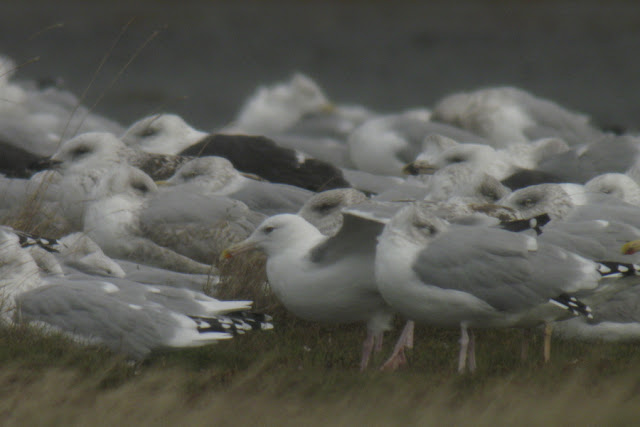Tuesday 26 October 2010
Monday 25 October 2010
Lesser Black-backed Gull (Larus fuscus graellsii), 2cy, 18.10.2010, Børsmose Strand
Putative Western Lesser Black-backed Gull (Larus fuscus graellsii). Judged only on upper part colors we cannot safely dismiss an intergrade between intermedius and graellsii (known as Dutch Intergrade), but it is much paler than a classical Danish breeding intermedius.
Herring Gull (Larus argentatus), 1cy, 22.10.2010, Aarhus Harbor
This is a 1cy Herring Gull with some Yellow-legged Gull features. It deserves a second look due to the pale headed appearance and fairly pale underparts, but argentatus Herring Gull seems as a valid identification. The bird as a whole looks like an elegant female Herring Gull, perhaps from the Baltic region.
Yellow-legged Gull features are: 1) outer greater covert pattern is rather uniformly dark, 2) few second generation coverts are present, 3) darkish outer web on inner primaries, although with a rather large pale 'window' on the outer web, perhaps a little too large for michahellis.
Herring Gull features are: 1) argentatus structure, with head shape perhaps not being angular enough for michahellis, 2) tertials having 'oak leaf' pattern with pale notching together with white edge reaching the greater coverts in some of the tertials, 3) fresh plumage without the normal wear associated with early breeding michahellis, 4) inner primaries with dark subterminal tip on inner and outer web, 5) bill size being in the short and slender end for michahellis, 6) tail pattern with narrow tail band and heavy patterned outer feathers is also more argentatus than michahellis like.
Plumage and proportions looks best for argentatus and the michahellis features are actually seen in some Herring Gulls. Not only are the michahellis features within argentatus variation, but michahellis can show notched tertials with white border reaching greater coverts, extensive pale inner webs on inner primaries and it can even show the dark subterminal primary blobs. Thus there is a lot of variation in most of the characters with some overlap between the two species.
The notched 'oak-leaf' tertials as shown by this bird would be very rare in michahellis seen in Denmark and mostly associated with more eastern Yellow-legged Gull such as around Bucharest as seen here, here, here, here, here, here, here, here and here.

All photos taken by Per G. Henriksen (PGH).
Yellow-legged Gull features are: 1) outer greater covert pattern is rather uniformly dark, 2) few second generation coverts are present, 3) darkish outer web on inner primaries, although with a rather large pale 'window' on the outer web, perhaps a little too large for michahellis.
Herring Gull features are: 1) argentatus structure, with head shape perhaps not being angular enough for michahellis, 2) tertials having 'oak leaf' pattern with pale notching together with white edge reaching the greater coverts in some of the tertials, 3) fresh plumage without the normal wear associated with early breeding michahellis, 4) inner primaries with dark subterminal tip on inner and outer web, 5) bill size being in the short and slender end for michahellis, 6) tail pattern with narrow tail band and heavy patterned outer feathers is also more argentatus than michahellis like.
Plumage and proportions looks best for argentatus and the michahellis features are actually seen in some Herring Gulls. Not only are the michahellis features within argentatus variation, but michahellis can show notched tertials with white border reaching greater coverts, extensive pale inner webs on inner primaries and it can even show the dark subterminal primary blobs. Thus there is a lot of variation in most of the characters with some overlap between the two species.
The notched 'oak-leaf' tertials as shown by this bird would be very rare in michahellis seen in Denmark and mostly associated with more eastern Yellow-legged Gull such as around Bucharest as seen here, here, here, here, here, here, here, here and here.

All photos taken by Per G. Henriksen (PGH).
Saturday 23 October 2010
Yellow-legged Gull (Larus michahellis), ad, 20.10.2010, Lakolk Strand, Rømø
 |
| This Yellow-legged Gull has darker upperparts than argentatus in direct comparison. Note hove the black on outer primaries reaches the primary coverts on the folded wing |
Caspian Gull (Larus cachinnans), 4cy+, 20.10.2010, Lakolk Strand, Rømø
This big male-type Caspian Gull has almost complete white summer head and the small darkish eye is situated closer to the flat forehead than in argentatus. The bill is without pronounced gonys angle.
Most likely a 4th winter individual due to black marking in primary coverts, relative large dark spot on upper mandible, and reminisces of classic winter neck-boa this late in season, where adults are typically in complete summer plumage by now.
Most likely a 4th winter individual due to black marking in primary coverts, relative large dark spot on upper mandible, and reminisces of classic winter neck-boa this late in season, where adults are typically in complete summer plumage by now.
 |
It is standing right behind the one with stretched wings in the left half of the photo
|
 |
| Preening in the middle of the photo. Just visible in this photo is the black marking on outer edge of p4, a massive black band on p5 and generally small white apical spots on primaries |
 |
| It has a good cachinnans jizz with high push up breast, flat belly slightly dropped behind legs and long elongated slim rear. Additionally the upperparts are slightly darker than nearby argentatus |
 |
| Most likely a 4th winter individual due to black marking in primary coverts |
Caspian Gull (Larus cachinnans), ad, 20.10.2010, Lakolk Strand, Rømø (#1)
 |
It has a good cachinnans jizz with high push up breast, flat belly slightly dropped behind legs. Additionally the upperparts are slightly darker than on nearby argentatus
|
 |
| The longer tibia compared to argentatus is quite distinctive |
Subscribe to:
Posts (Atom)











































